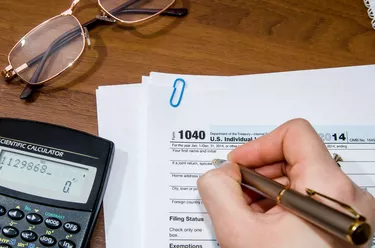
Usually, people who are expecting a refund love tax time, while people who know that they will owe the government money hate it. Some people get excited about tax time because, to them, it is the time of year that the government hands out "free money."
At the same time, others just look forward to getting back the extra money they paid in taxes during the year. New taxpayers might as, "What is a federal tax refund?" If you're getting a refund, you can deposit it into different accounts, but you must deposit at least one dollar into each account.
Video of the Day
Video of the Day
Consider also: Where's My Tax Refund: An Easy Guide
An Unintentional Overpayment
Most people have federal taxes taken out of their paycheck each pay period. The goal is for enough money to be taken out of each paycheck to cover the amount of federal taxes that will be owed at the end of the year. Often, more money is withheld during the year than was actually necessary, and the person will receive a federal income tax refund for any extra money he gave to the government during the year.
An Intentional Overpayment
Some people are not good at saving money, so they may opt to set up a forced savings account by intentionally overpaying their federal taxes each period from their paycheck. They set this up by filling out a W-4 form and asking that a specific amount of additional money be withheld from their paycheck each week for their federal taxes.
At the end of the year, they file their taxes, and the government sends them back all of the money that they overpaid during the year. This gives them one lump sum of money.
Read More: Filing an Extension for Taxes
Earned Income Credit
People who work but do not make very much money can qualify for a federal tax refund called the Earned Income Credit. This refund is calculated based on how much money a person made and how many children he or she has (although you can qualify without children). You can check at the IRS website to see if you qualify, and for how much.
Read More: Tax Credits: What Are They & How Do You Qualify?
Other Refundable Tax Credits
Each year Congress votes on programs to offer credits which result in a tax refund for people who may otherwise not receive one. While many tax credits can only lower your tax liability to zero, refundable credits do more than that.
If a person owes $300 in taxes and they earn a $500 credit from one of these programs, the government will actually send them the difference of $200. An example is the Child Tax Credit of up to $3,600.
Receiving the Refund
Refunds are received in three basic ways. The first and most traditional way is by the IRS sending a paper check to the tax payer. Checks are generally mailed within a week of the time the tax return is reviewed, which can take up to six weeks after submitting it to the IRS. Expecting it to take a week in the mail, a paper check can take up to eight weeks to receive.
The second, and smartest, way is to have the refund directly deposited into a bank account. The IRS even allows you to split the amount between two bank accounts. Direct deposit refunds are faster and are usually deposited immediately upon your tax return being reviewed. This cuts out the extra few weeks needed to send a paper check.
Finally, a tax payer can go to a major tax preparation company and get an instant "refund anticipation loan." These loans allow the person to get their refund the same day that the tax return is filed. These refund loans, however, come at a steep price and most people would be better off waiting for the tax return to come on its own.